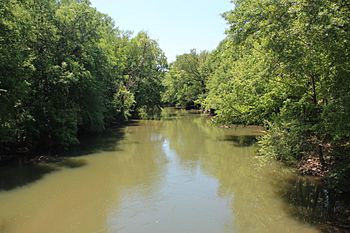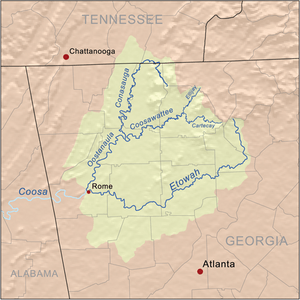Conasauga River facts for kids
Quick facts for kids Conasauga River |
|
|---|---|

View of the Conasauga River
|
|
 |
|
| Physical characteristics | |
| Main source | Cohutta Mountain ~ 2,400 feet (730 m) |
| River mouth | Oostanaula River near Calhoun, GA ~ 610 feet (190 m) |
| Length | 93 miles (150 km) |
| Basin features | |
| Basin size | 772 sq mi (2,000 km2) |
The Conasauga River is a cool river that flows through parts of Tennessee and Georgia in the southeastern United States. It's about 93 miles (150 km) (150 km) long. This river is super important because it's home to many different kinds of fish and freshwater mussels. Its entire water area, called a watershed, covers a huge space across two states.
Contents
Where is the Conasauga River Located?
The Conasauga River is special because it's the westernmost place in Georgia where you can find trout on public land. It's also the only river in Tennessee that doesn't flow into the huge Mississippi River system.
You can reach the Conasauga River by car using roads like Old GA 2, GA 2, and Carlton Petty Road. If you prefer hiking, there are trails! You can find a trail from Forest Service road (FS) 64 at Betty Gap. Other trails like Chestnut Lead (2.0 miles (3.2 km)), Tearbritches Trail (4.0 miles (6.4 km)), and Hickory Creek Trail (3.0 miles (4.8 km)) also lead to the river. You can even go camping along the river!
Amazing Nature and Wildlife
A big part of the Conasauga River's area is within the Cohutta Wilderness. This wild area covers over 35,268 acres (142.72 km2) and is managed by the United States Forest Service. It's part of the Chattahoochee National Forest and Cherokee National Forest. The preserve includes about 15 miles (24 km) of the Conasauga River itself.
The Conasauga River is like a giant aquarium! It has more than 90 types of fish. Some of these fish and mussels are very rare and protected by law. While there used to be 42 kinds of freshwater mussels, only 25 species live there now.
If you like fishing, you might find wild rainbow trout and browns here. Rainbow trout can grow up to 20 inches (510 mm) long, and brown trout can weigh up to 9 pounds (4.1 kg)! Besides fish, the land around the river is home to many animals. You might see white-tailed deer, wild hogs, black bears, and lots of smaller animals.
Protecting the River
Like many rivers, the Conasauga River faces some challenges. Parts of the river and its smaller streams have been affected by pollution. This means that some substances have gotten into the water that can harm the plants and animals living there.
For example, a lot of water from the river near Dalton, Georgia is used by factories that make carpets. Sometimes, chemicals used to make carpets stain-resistant have also gotten into the river. People are working hard to clean up the river and protect it for the future.
What Does "Conasauga" Mean?
The name "Conasauga" comes from the Cherokee language. It means "grass." Over time, the river has been known by a few different names, including Connasauga River and Slave River. The Jacks River is now the name of a smaller river that flows into the Conasauga.
Images for kids


